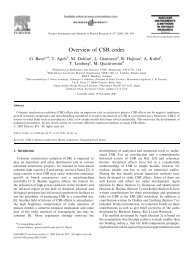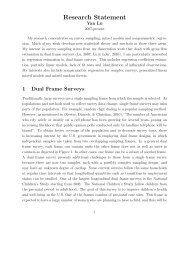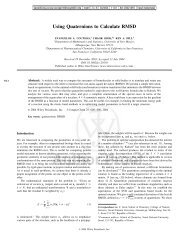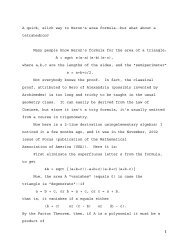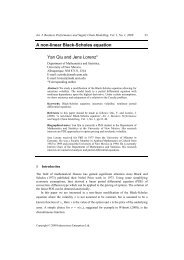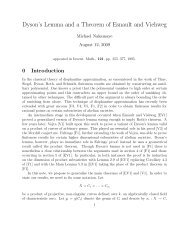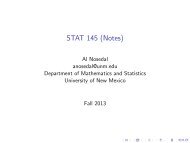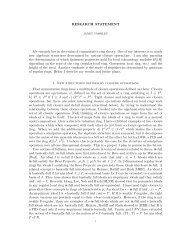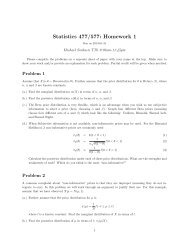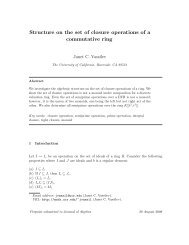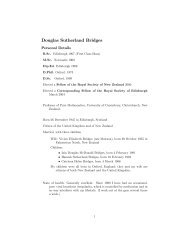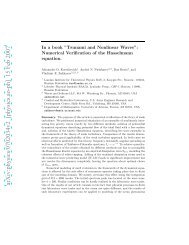OEO Office of Equal Opportunity - Department of Mathematics and ...
OEO Office of Equal Opportunity - Department of Mathematics and ...
OEO Office of Equal Opportunity - Department of Mathematics and ...
You also want an ePaper? Increase the reach of your titles
YUMPU automatically turns print PDFs into web optimized ePapers that Google loves.
168 ARTS AND SCIENCES<br />
340. Communication in Organizations. (3)<br />
Examines current theories <strong>of</strong> organizational behavior with<br />
emphasis on communication patterns <strong>and</strong> practices. Attention<br />
to superior-subordinate communication, formal <strong>and</strong> informal<br />
communication networks, authority <strong>and</strong> power.<br />
344. Interviewing. (3)<br />
Theory <strong>and</strong> practice <strong>of</strong> interviewing for informational, journalistic,<br />
employment <strong>and</strong> decision-making purposes.<br />
360. Broadcast News I. (3)<br />
Gathering <strong>and</strong> reporting news for television. Instruction in<br />
shooting <strong>and</strong> editing videotape; writing to picture; <strong>and</strong> writing,<br />
producing <strong>and</strong> anchoring short news programs.<br />
Prerequisite: 268 or 269. Pre or corequisite: 271.<br />
361. Photojournalism II. (3-6)<br />
Continues with greater emphasis on camera reporting, color<br />
photography, weekly news assignments, scaling photos for<br />
reproduction <strong>and</strong> advanced black <strong>and</strong> white darkroom techniques.<br />
For majors only.<br />
Prerequisite: 261. Restriction: CJ major.<br />
362. Broadcast Station Operations. (3)<br />
Examination <strong>of</strong> media production units <strong>and</strong> outlets from an<br />
organizational perspective. Study <strong>of</strong> the roles <strong>of</strong> management<br />
<strong>and</strong> administrative personnel, market analysis <strong>and</strong><br />
advertising sales.<br />
364. Broadcast News II. (3)<br />
Continuation <strong>of</strong> CJ 360. Students create longer, more elaborate<br />
programs with their own documentary segments, essays<br />
<strong>and</strong> in-studio interviews.<br />
Prerequisite: 360.<br />
365. Social Foundations <strong>of</strong> Media. (3)<br />
The course will exlore the development <strong>of</strong> communication<br />
media in the United States <strong>and</strong> the social <strong>and</strong> cultural contexts<br />
within which media emerged <strong>and</strong> evolved over time.<br />
368. Media Criticism. (3)<br />
Evaluation <strong>of</strong> radio/television programming content from<br />
the perspective <strong>of</strong> the journalistic <strong>and</strong> academic critic.<br />
Examination <strong>of</strong> theoretical issues <strong>and</strong> production elements<br />
as they affect programming genres.<br />
371. Persuasive Writing. (3)<br />
Writing the editorial essay, the column <strong>and</strong> other interpretive<br />
matters.<br />
Prerequisite: 271.<br />
372. Copy-Editing <strong>and</strong> Makeup. (3)<br />
Practice in editing <strong>and</strong> presenting news copy by headlines,<br />
typography, page makeup <strong>and</strong> video display terminal.<br />
Pre- or corequisite: 271.<br />
373. Magazine Writing. (3)<br />
The process <strong>of</strong> writing <strong>and</strong> marketing fiction <strong>and</strong> non-fiction<br />
for magazines.<br />
374. Desktop Publishing. (3)<br />
Introduction to writing, editing <strong>and</strong> designing newsletters <strong>and</strong><br />
other short publications using personal computers <strong>and</strong> desktop<br />
publishing s<strong>of</strong>tware. Emphasis will be on the layout <strong>and</strong> design<br />
<strong>of</strong> newsletters with special attention to readability. Basic competency<br />
in the use <strong>of</strong> personal computers is required.<br />
375. Intermediate Reporting. (3)<br />
Emphasis on reporting complex affairs, the news feature story,<br />
developing <strong>and</strong> covering beats <strong>and</strong> specialized interests.<br />
Prerequisite: 271.<br />
376. Media Management. (3)<br />
This course is designed to provide insights into the management<br />
<strong>and</strong> ownership aspects <strong>of</strong> running a media company.<br />
Attention will be given to leadership skills <strong>and</strong> the complex<br />
operations <strong>of</strong> media companies.<br />
380. Introduction to Advertising. (3)<br />
Theory, strategy <strong>and</strong> techniques <strong>of</strong> advertising <strong>and</strong> advertising<br />
campaigns.<br />
Prerequisite: 271.<br />
381. Advertising Media Planning. (3)<br />
Development <strong>of</strong> media strategy for integrated marketing<br />
communications <strong>and</strong> the appropriate media for specific<br />
advertising messages to target audiences. The fundamentals<br />
<strong>of</strong> media evaluation, selection, cost, scheduling, <strong>and</strong> media<br />
audience research.<br />
384. Advertising Copywriting. (3)<br />
The theory, strategy <strong>and</strong> practice <strong>of</strong> developing advertising<br />
copy for use in a variety <strong>of</strong> print <strong>and</strong> electronic media<br />
formats.<br />
Prerequisite: 380.<br />
385. Introduction to Public Relations. (3)<br />
Techniques <strong>and</strong> strategies employed by public relations practitioners.<br />
Emphasis upon history, theory <strong>and</strong> skills necessary<br />
to enter the pr<strong>of</strong>essional arena.<br />
Prerequisite: 271.<br />
393. Topics in Communication <strong>and</strong> Journalism. (1-3 to<br />
a maximum <strong>of</strong> 6) [1-3 to a maximum <strong>of</strong> 12] ∆<br />
400. Senior Seminar: Perspectives on Communication.<br />
(3)<br />
In this capstone course, seniors assess the theories, concepts<br />
<strong>and</strong> skills learned throughout their communication<br />
major <strong>and</strong> apply them to real-world situations as well as to the<br />
fulfillment <strong>of</strong> pr<strong>of</strong>essional, personal <strong>and</strong> social goals.<br />
Prerequisites: 300 <strong>and</strong> 301 <strong>and</strong> (332 or 333).<br />
413. Studies in Intercultural Communication. (3 to a<br />
maximum <strong>of</strong> 6) ∆<br />
Intensive study <strong>of</strong> theory <strong>and</strong> research in intercultural communication<br />
concerning interactions between members <strong>of</strong> specific<br />
cultures chosen by the instructor. Content varies from semester<br />
to semester, may be repeated with different content.<br />
Prerequisite: 314.<br />
421. Interpersonal Communication Analysis. (3)<br />
Advanced analysis <strong>of</strong> theories <strong>and</strong> research in interpersonal<br />
communication with emphasis on communication processes,<br />
relational development <strong>and</strong> conflict resolution.<br />
Prerequisite: 221.<br />
425. Theories <strong>of</strong> Small Group Communication. (3)<br />
Major concepts, theories <strong>and</strong> research in small group communication<br />
with attention given to decision-making, group<br />
formation <strong>and</strong> development, <strong>and</strong> communication processes<br />
<strong>and</strong> networks. Consideration <strong>of</strong> applications in a variety <strong>of</strong><br />
contexts.<br />
Prerequisite: 225.<br />
*430. American Religious Communication. (3)<br />
(Also <strong>of</strong>fered as RELG 430.) The roles <strong>of</strong> religious communication<br />
during the Puritan period, the first <strong>and</strong> second<br />
awakenings <strong>and</strong> the period <strong>of</strong> media evangelism. The course<br />
examines various types <strong>of</strong> communicators, messages, audiences<br />
<strong>and</strong> channels <strong>of</strong> persuasion.<br />
*435. Legal Communication. (3)<br />
Using historical trials as case studies, the course investigates<br />
the various communicative functions <strong>of</strong> litigation including<br />
media coverage, opening statements, direct <strong>and</strong> crossexamination,<br />
closing arguments, judge’s instructions <strong>and</strong><br />
appellate arguments.<br />
441. Advanced Organizational Communication. (3)<br />
Intensive study <strong>of</strong> current organizational communication<br />
issues with an emphasis on decision making <strong>and</strong> problem<br />
solving. Students learn <strong>and</strong> apply advanced critical thinking<br />
<strong>and</strong> analytical skills to organizational case studies.<br />
443. Topics in Organizational Communication. [Current<br />
Developments in Organizational Communication.] (3 to a<br />
maximum <strong>of</strong> 6) ∆<br />
Intensive study <strong>of</strong> one area <strong>of</strong> theory <strong>and</strong> research in organizational<br />
communication chosen by the instructor, e.g., conflict<br />
<strong>and</strong> negotiation, information technology, organizational<br />
cultures. Content varies from semester to semester; may be<br />
repeated with different content.<br />
Prerequisite: 340.<br />
UNM CATALOG 2006–2007 Symbols, page 611.



